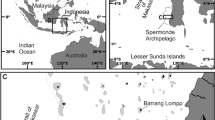Abstract
Bathymetry across the carbonate platform off western India indicated small-size pinnacles and their lateral coalescence into 2 -6-m high mounds landward, and linear elongated carbonate ridges and troughs, mounds and banks up to a height of 20-m seaward of the platform. Seismic data indicated that these mounds were transparent with no rigid internal structure and can be defined as bioherms. The sediments were abundantly aragonite faecal pellets, Halimeda grains and ooids and their radiocarbon ages ranged from 11 to 7.5 ka BP. It appears that the growth of Halimeda bioherms on the platform was facilitated by intense upwelling during the early Holocene. The terrigenous sediments brought by rivers were deposited in the inner shelf and have not affected the growth of bioherms. It is estimated that the platform comprises at least 1.85 Gt of mass CaCO\(_3\) accumulated during the early Holocene and comparable to those on the Great Barrier Reef. Halimeda bioherms produce abundant carbonate sediments and their growth period represents a geological carbonate sink and release of high CO\(_2\) to the atmosphere. Detailed shallow seismic studies and sediment cores are needed to quantify the exact mass content of CaCO\(_3\) and model climate change during the early Holocene.










Similar content being viewed by others
References
Basu D N, Banerjee A and Tamhane D M 1980 Source areas and migration trends of oil and gas in Bombay offshore Basin, India; Am. Assoc. Petrol. Geol. Bull. 64 209–220.
Braga J C and Martin J M 1993 Halimeda bioherms in Messinian basinal sequences: Fossil analogues of modern Australian examples; In: International Symposium on Alpine Algae, Abstracts, Munich, University of Munich, 94p.
Braga J C, Martin J M and Riding R 2015 Internal structure of segment reefs: Halimeda algal mounds in the Mediterranean Miocene; Geology 24 35–38.
Drew E A and Abel K M 1985 Biology, sedimentology and geography of the vast inter-reefal Halimeda meadows within the Great Barrier Reef province; In: Proceedings of the Fifth International Coral Reef Congress, 5, pp. 15–20.
Elliot G F 1965 The inter-relationships of some Cretaceous Codiaceae (calcareous algae); Palaeontology 8 199–203.
Fornos J J, Forteza V and Jaume C 1992 Present-day Halimeda carbonate sediments in temperate Mediterranean embayments: Fornells, Balearic Islands; Sedim. Geol. 75 283–293.
Freile D 2004 Carbonate productivity rates of Halimeda in two different locations, San Salvador Island, Bahamas; In: Proceedings of the 11th Symposium on the Geology of the Bahamas and other Carbonate Regions (eds) Lewis R D and Panuska B C, Gerace Research Center, San Salvador, Bahama; Production Center, Auburn University, Auburn, AL, pp. 95–106.
Hallock P, Hine A C, Vargo G A, Elrod J A and Japp W J 1988 Platforms of nicaraguan rise: Examples of the sensitivity of carbonate sedimentation to excess trophic resources; Geology 16 1104–1107.
Hallock P and Schlager W 1986 Nutrient excess and the demise of coral reefs and carbonate platforms; Palaios 1 389–398.
Harris P T, Pattiaratchi C B, Keene J B, Dalrymple R W, Gardner J V, Baker E K, Cole A R. Mitchell D, Gibbs P and Schroeder W W 1996 Late quaternary deltaic and carbonate sedimentation in the Gulf of Papua foreland basin: Response to sea-level change; J. Sedim. Res. \(A\) 66 4801–4819.
Hay M E, Paul V J, Lewis S M, Gustafson K, Tucker J and Trindell R N 1988 Can tropical seaweeds reduce herbivory by growing at night? Diel patterns of growth, nitrogen content, herbivory, and chemical versus morphological defenses; Oecologia 75 233–245.
Henriet J-P, Spezzaferri S, Samankassou E, Foubert A, Van Rooij D and Rüggeberg A 2011 Carbonate mounds in shallow and deep time; Mar. Geol. 282 1–4.
Heyward A, Pinceratto E and Smith L D 1997 Big bank shoals of the Timor sea: An environmental resource atlas; Australian Institute of Marine Science and BHP Petroleum, Townsville, Australia, 95p.
Hillis-Colinvaux L 1980 Ecology and taxonomy of Halimeda: Primary producer of coral reefs; Adv. Mar. Biol. 17 1–327.
Hillis-Colinvaux L 1986 Halimeda growth and diversity on the deep forereef of Eniwetak Atoll; Coral Reefs 5 19–21.
Hillis L 1997 Coralgal reefs from a calcareous green alga perspective and a first carbonate budget; In: Proceedings of the Eighth International Coral Reef Symposium, 1, pp. 761–766.
Hine A C, Hillock P, Harris M W, Mullins H T, Belknap D F and Jaap W C 1988 Halimeda bioherms along an open seaway: Miskito channel, Nicaraguan rise, SW Caribbean Sea; Coral Reefs 6 173–178.
Hopley D 1994 Continental shelf reef systems. In: Coastal evolution, late Quaternary shoreline morphodynamics (eds) Carter R W G and Woodroffe C D, Cambridge University Press, Cambridge, pp. 303–340.
Hoskin C M, Reed J K and Mook D H 1986 Production and off-bank transport of carbonates sediment, black rock, southwest little Bahama bank; Mar. Geol. 73 125–144.
Kessarkar P M, Rao V P, Naqvi S W A and Karapurkar S G 2013 Variation in the Indian summer monsoon intensity during the Bølling-Ållerød and Holocene; Paleoceanography 28 413–425.
Kirkland B L, Moore C H Jr and Dickson J A D 1993 Well preserved aragonite algae (Eugonophyllum U’doteaceae) from the Pennsylvanian holder formation, Sacramento mountains, New Mexico; Palaios 8 111–120.
Liddell W D, Ohlhorst S L and Boss S K 1988 The significance of Halimeda as a space-occupier and sediment-producer, 1–750 m; In: The Sixth International Coral Reef Symposium (Abstract), North Jamaica, 63p.
Littler M M, Littler D S and Lapointe B E 1988 A comparison of nutrient- and light-limited photosynthesis in psammophytic versus epilithic forms of Halimeda (Caulerpales, Halimedaceae) from the Bahamas; Coral Reefs 6 219–225.
Marshall J F and Davies P J 1988 Halimeda bioherms of the northern Great Barrier Reef; Coral Reefs 6 139–148.
Milliman J D 1974 Recent Sedimentary Carbonates, Part I, Marine Carbonates; Springer, Berlin, Heidelberg, New York, 375p.
Milliman J D 1993 Production and accumulation of calcium carbonate in the ocean: Budget of a non-steady state; Global Biogeochem. Cycles 7 927–957.
Multer H G 1988a Growth rate, ultrastructure and sediment contribution of Halimeda incrassata and Halimeda monile, Nonsuch and Falmouth Bays, Antigua, W.I.; Coral Reefs 6 179–186.
Multer H G 1988b Notes on stress-recovery, abnormal growth, stabilization mechanisms and segment preservation of Halimeda, Antigua, W.I.; In: The Sixth International Coral Reef Symposium (Abstract), 74p.
Muni Krishna K 2008 Coastal upwelling along the southwest coast of India – ENSO modulation; Ann. Geophys. 26 1331–1334.
Nair R R 1971 Beach rock and associated carbonate sediments on the fifty fathom flat, a submarine terrace on the outer continental shelf of Bombay; Proc. Indian Acad. Sci. Sect. B 73 148–154.
Nair R R 1975 Nature and origin of small scale topographic prominences on the western continental shelf of India; Indian J. Mar. Sci. 4 25–29.
Nair R R and Hashimi N H 1981 Mineralogy of the carbonate sediments western continental shelf of India; Mar. Geol. 41 309–319.
Nair R R and Pylee A 1968 Size distribution and carbonate content of the sediments of the western shelf of India; Bull. Natl. Inst. Sci. India 38 411–420.
Nair R R, Hashimi N H and Guptha M V S 1979 Holocene limestones of part of the western continental shelf of India; J. Geol. Soc. India 20 17–23.
Nair R R, Hashimi N H and Rao V P 1982 On the possibility of high-velocity tidal streams as dynamic barriers to longshore sediment transport: Evidence from the continental shelf off the Gulf of Kutch, India; Mar. Geol. 47 77–86.
Orme G R 1985 The sedimentological importance of Halimeda in the development of back-reef lithofacies, northern Great Barrier Reef (Australia); In: Proceedings of the Fifth International Coral Reef Congress, Tahiti, 5, pp. 31–37.
Orme G R, Flood P G and Sargent G E G 1978 Sedimentation trends in the lee of the outer (ribbon) reefs, northern region of the Great Barrier Reef Province; Phil. Trans. Roy. Soc. London A 291 85–99.
Orme G R and Salama M S 1988 Form and seismic stratigraphy of Halimeda banks in part of the northern Great Barrier Reef Province; Coral Reefs 6 131–137.
Overholtzer K L and Motta P J 1999 Comparative resource use by juvenile parrot fishes in the Florida Keys; Mar. Ecol. Prog. Ser. 177 177–187.
Paul V J and van Alstyne K L 1988 Antiherbivore defenses in Halimeda: Effects against generalist and specialist herbivores; In: The Sixth International Coral Reef Symposium (Abstract), 78p.
Pennings S C and Paul V J 1992 Effect of plant toughness, calcification, and chemistry on herbivory by Dolabella auricularia; Ecology 73 1606–1619.
Phipps C V G, Davies P J and Hopley D 1985 The morphology of Halimeda banks behind the Great Barrier Reef east of Cooktown, Queensland; In: The Fifth International Coral Reef Symposium, 5, pp. 27–30.
Phipps C V G and Roberts H H 1988 Characteristics and environments formation of Indonesian Halimeda bioherms; In: The Sixth International Coral Reef Symposium, 79p.
Pratt B R 1995 The origin, biota and evolution of deep-water mudmounds. In: Carbonate Mud-Mounds: Their Origin and Evolution (eds) Monty C L V, Bosence D WJ, Bridges P H and Pratt B R, Int. Assoc. Sedimentol. Spec. Publ. 23 49–123.
Prell W L 1984 Variation of monsoonal upwelling: A response change in varved sediments from the oxygen minimum to changing solar radiation; In: Climate Processes and Climate Sensitivity (eds) Hansen J E and T Takahashi, Geophysics, AGU, Washington DC, 51 39–53.
Price N N, Hamilton S L, Tootell J S and Smith J E 2011 Species-specific consequences of ocean acidification for the calcareous tropical green algae Halimeda; Mar. Ecol. Progr. Ser. 140 67–78.
Rao K L 1975 India Water Wealth, Orient Longman, New Delhi, 255p.
Rao V P and Veerayya M 1996 Submarine terrace limestones from the continental slope off Saurashtra-Bombay: Evidence of late quaternary neotectonic activity; Curr. Sci. 71 36–41.
Rao V P, Anil Kumar A, Naqvi S W A, Chivas A R, Sekar B and Kessarkar P M 2012 Lime muds and their genesis off-Northwestern India during the late quaternary; J. Earth Syst. Sci. 121 769–779.
Rao V P, Kessarkar P M, Krumbein W E, Krajewski K P and Schneider R J 2003a Microbial dolomite crusts from the carbonate platform off western India; Sedimentology 50 819–830.
Rao V P, Montaggionni L, Vora K H, Almeida F, Rao K M and Rajagopalan G 2003b Significance of relict carbonate deposits along the central and southwestern margin of India for environmental and sea level changes; Sed. Geol. 159 95–111.
Rao V P and Milliman J D 2017 Relict ooids off northwestern India: Inferences on their genesis and late quaternary sea level; Sed. Geol. 358 44–50.
Rao V P, Veerayya M, Nair R R, Dupeuble P A and Lamboy M 1994 Late quaternary Halimeda bioherms and aragonitic faecal pellet-dominated sediments on the carbonate platform of the western continental shelf of India; Mar. Geol. 121 293–315.
Rees S A, Opdyke B N, Wilson P A and Field L K 2005 Coral reef sedimentation on Rodrigues and the western Indian ocean and its impact on the carbon cycle; Phil. Trans. Roy. Soc. London A 363 101–120.
Rees S A, Opdyke B N, Wilson P A and Henstock T J 2007 Significance of Halimeda bioherms to the global carbonate budget based on a geological sediment budget for the northern great barrier reef, Australia; Coral Reefs 26 177–188.
Riding R 2002 Structure and composition of organic reefs and carbonate mud mounds: Concepts and categories; Earth Sci. Rev. 58 163–231.
Roberts H H and Phipps C V 1988 Proposed oceanographic controls on modern Indonesian reefs: A turn on/turn off mechanism in a monsoonal setting; In: The Sixth International Coral Reef Symposium, 87p.
Roberts H H, Phipps C V and Effendi L 1987a Halimeda bioherms of the eastern Java Sea, Indonesia; Geology 15 371–374.
Roberts H H, Phipps C V and Effendi L 1987b Morphology of large Halimeda bioherms, eastern Java sea (Indonesia): A side scan sonar study; Geo-Mar. Lett. 7 7–14.
Roberts H H, Aharon P and Phipps C V 1988 Morphology and sedimentology of Halimeda bioherms from the eastern Java sea (Indonesia); Coral Reefs 6 161–172.
Scoffin T P and Tudhope A W 1985 Sedimentary environments of the central region of the great barrier reef of Australia; Coral Reefs 4 81–93.
Searle D E and Flood P G 1988 Halimeda bioherms of the Swain Reefs – Southern Great Barrier Reef; In: The Sixth International Coral Reef Symposium, 92p.
Sirocko F, Sarnthein M, Erlenkeuser H, Lange H, Arnold M and Duplessy J C 1993 Century-scale events in monsoonal climate over the past 24,000 years; Nature 364 322–324, https://doi.org/10.1038/364322a0.
Thamban M, Kawahata H and Rao V P 2007 Indian summer monsoon variability during the Holocene as recorded in sediments of the Arabian Sea: Timing and implications; J. Ocean 63 1009–1020.
Thamban M, Rao V P, Schneider R R and Grootes P M 2001 Glacial to Holocene fluctuations in hydrography and productivity along the southwestern continental margin of India; Palaeogeogr. Palaeoclimatol. Palaeoecol. 165 113–127.
Wefer G 1980 Carbonate production by algae Halimeda, Penicillus and Padina; Nature 285 323–324.
Wolanski E J, Drew E A, Abel K M and O’Brien J 1988 Tidal jets, nutrient upwelling and their influence on the productivity of the alga Halimeda in the Ribbon Reefs, Great Barrier Reef; East. Coast. Shelf. Sci. 26 169–201.
Wood R 2001 Are reefs and mud mounds really so different? Sedim. Geol. 145 161–171.
Xu H, Zhao X, Eberli G P, Liu X, Zhu Y, Cai Y, Luo W, Yan B G, Zhang B, Wei K and Shi J 2015 Biogenic carbonate formation and sedimentation in the Xisha Islands: Evidences from living Halimeda; Acta Oceanol. Sin. 34 62–73.
Acknowledgements
The authors thank the Director, CSIR-National Institute of Oceanography (CSIR-NIO), Goa for providing facilities and encouragement. Multibeam bathymetry was collected under Exclusive Economic Zone (EEZ) Project to Dr B Chakraborty, funded by the Ministry of Earth Sciences, New Delhi. We thank Dr B G Wagle and Dr S M Karisiddaiah for the bathymetric data. Dr Rao thanks Vignan’s University for providing facilities to execute writing of this paper.
Author information
Authors and Affiliations
Corresponding author
Additional information
Corresponding editor: N V Chalapathi Rao
Rights and permissions
About this article
Cite this article
Rao, V.P., Mahale, V.P. & Chakraborty, B. Bathymetry and sediments on the carbonate platform off western India: Significance of Halimeda bioherms in carbonate sedimentation. J Earth Syst Sci 127, 106 (2018). https://doi.org/10.1007/s12040-018-1014-4
Received:
Revised:
Accepted:
Published:
DOI: https://doi.org/10.1007/s12040-018-1014-4




